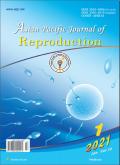紫杉醇可减轻大鼠缺血再灌注引起的卵巢氧化损伤
IF 0.6
Q4 REPRODUCTIVE BIOLOGY
引用次数: 3
摘要
目的:探讨杉木素对大鼠缺血再灌注氧化性卵巢损伤的预防作用。方法:将18只雌性Wistar白化大鼠随机等分分为假手术组、卵巢缺血再灌注组和50 mg/kg taxifolin+卵巢缺血再灌注组。卵巢缺血再灌注组和taxifolin+卵巢缺血再灌注组分别缺血2 h,再灌注2 h。对摘除的卵巢进行生化及组织病理学检查。结果:卵巢缺血再灌注组丙二醛、环氧化酶-2水平升高,还原性谷胱甘肽、环氧化酶-1水平降低。然而,在taxifolin+卵巢缺血再灌注组,这些值是相反的。卵巢缺血再灌注组原始卵泡和发育卵泡数量减少,而taxifolin+卵巢缺血再灌注组则在正常范围内。结论:缺血再灌注导致卵巢氧化应激相关损伤,紫杉醇素可能具有保护卵巢组织免受氧化应激损伤的作用。本文章由计算机程序翻译,如有差异,请以英文原文为准。
Taxifolin attenuates ischemia-reperfusion induced oxidative ovarian damage in rats
Objective: To investigate preventive effects of taxifolin on ischemia-reperfusion induced oxidative ovarian damage in rats. Methods: A total of 18 female Wistar albino rats were randomly and equally divided into three groups: the sham group, the ovarian ischemia reperfusion group, and the 50 mg/kg taxifolin+ovarian ischemia reperfusion group. The ovarian ischemia reperfusion and taxifolin+ovarian ischemia reperfusion groups were exposed to ischemia for 2 h and then followed by two-hour reperfusion protocol. Biochemical and histopathologic examinations were performed on the extracted ovaries. Results: Levels of malondialdehyde and cyclooxygenase-2 were increased, while reduced-glutathione and cyclooxygenase-1 were decreased in the ovarian ischemia reperfusion group. However, these values were reversed in the taxifolin+ovarian ischemia reperfusion group. Similarly, the number of primordial and developing follicules decreased in the ovarian ischemia reperfusion group, while they were within normal range in the taxifolin+ovarian ischemia reperfusion group. Conclusions: Ischemia followed by reperfusion leads to oxidative stress-related ovarian injury, and taxifolin may be useful for protecting ovarian tissue from such injury.
求助全文
通过发布文献求助,成功后即可免费获取论文全文。
去求助
来源期刊

Asian Pacific Journal of Reproduction
Veterinary-Veterinary (all)
CiteScore
1.70
自引率
0.00%
发文量
588
审稿时长
9 weeks
期刊介绍:
The journal will cover technical and clinical studies related to health, ethical and social issues in field of Gynecology and Obstetrics. Articles with clinical interest and implications will be given preference.
 求助内容:
求助内容: 应助结果提醒方式:
应助结果提醒方式:


